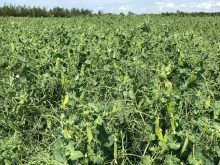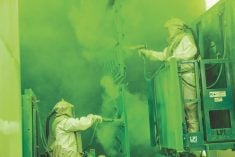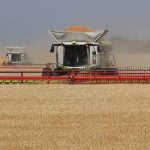In February, Farm Credit Canada released recommendations for farmers to navigate the challenges 2022 might present. According to FCC, this year is going to be a balancing act between growth, innovation and risk management, in which strategic planning will play a large role.
“Canadian producers are encouraged to lean into their strategic planning skills this year to meet what’s ahead,” states FCC in a February press release. “According to FCC economic outlooks, challenges impacting the food supply chain will continue but the demand for commodities and food means there is opportunity for growth, indicating a need for farms, agribusinesses and food processors to innovate and manage risk.”
Read Also

Health hazards are often overlooked risks on the farm
While quite different from the dangers posed by farm machinery, hazards such as loud noise or sun exposure require the same proactive attention, the Canadian Agricultural Safety Association says.
Prices for grains, oilseeds and pulses will remain strong into 2022, suggests FCC’s outlook, resulting from low national and global commodities supplies, in part, and worsened by 2021’s drought in Western Canada.
Soybean and canola acres are expected to increase in 2022 because of the strong prices, meanwhile corn acres are expected to decrease due to high fertilizer costs.
According to FCC, the cattle market is also signalling strong prices for 2022. “The number of fed cattle in 2022 is forecast to decline and because of high feed costs, fed cattle will likely be marketed at lower weights, causing volume by weight to decline. However, given higher prices, cattle receipts should grow. The drought seriously impacted access to feed, resulting in some cattle producers downsizing their operations.”
The pandemic has affected buying decisions in grocery aisles, says J.P. Gervais, FCC’s chief economist. “Canadian beef consumption slowed in 2021, but the positive five-year trend in consumption pre-pandemic is expected to resume while export demand remains robust,” he says.
Tips for farmers, J.P. Gervais
Gervais recommends farmers build resilience and capitalize on opportunities to grow profitability on their farms with the following tips:
- Strategy — keep an eye on long-term objectives, including growth. Think about the integration of operational, marketing and financial plans.
- Innovation — consider the technological changes, efficiencies and sustainable practices that would provide an edge to your operation.
- Risk management — develop scenarios to determine exposure to unfavourable market trends, interest rate increases, higher input prices, trade impacts or weather events.
- Execution — surround yourself with skilled resources to help you assess and adjust your financial and marketing plans as the economy and markets evolve.
Gervais says looking at the year ahead, while there is optimism for the grains, oilseeds and pulses sector, “two of the biggest economic trends that could impact profitability are rising crop input costs and the impact of global political tensions on trade.”
Rising fertilizer costs
Already, increasing global energy costs pushed manufacturing costs for fertilizer higher in 2021, “resulting in lower global production and restrictions on exports,” states a December 2021 FCC report on supply chain disruptions and challenges for crop input suppliers. As a result, China, the largest global producer and exporter of fertilizer (it supplies about 10 per cent of global urea and 30 per cent of global phosphate), put export restrictions in place last July to ensure its domestic supplies. Those restrictions will be in place until at least the end of June this year.
In Europe, rising energy costs (European natural gas prices increased fivefold), forced “high-cost manufacturing jurisdictions to shut down or curtail fertilizer production.” This resulted in a 10 per cent reduction in global ammonia capacity. And lower European production, “creates opportunities for North American exports and supports higher prices, with ammonia fertilizer prices doubling in the past year. North American manufacturers are expected to boost fertilizer production to replenish North American supplies for spring seeding. However, fertilizer prices are expected to remain elevated as export demand remains strong,” states the December report.
Even with the 2021 drought across the Prairies and reduced fertilizer applications last fall, Canadian fertilizer inventories fell across most categories as strong demand supported increased exports to the United States. And demand this spring is expected to be strong.
Fertilizer affordability has recently declined due to global supply constraints, but strong canola prices have lessened the effect of high fertilizer prices. However, FCC’s Economics division projects fertilizer prices will rise 60 per cent in 2022. This after fertilizer prices doubled from December 2020 to December 2021.
“In response to rising prices, producers may re-evaluate their seeding intentions or reduce application rates. In Western Canada, higher fertilizer residuals caused by the drought may result in reduced application rates,” states FCC’s December report.
And then Russia invaded Ukraine on Feb. 24.
Russia is the world’s fourth-largest producer of nitrogen fertilizers. The country had already put in place a six-month restriction on exports of nitrogen and phosphate fertilizers to increase its domestic supplies on Dec. 1, 2021. On March 4, Russia’s trade and industry ministry recommended the country’s fertilizer producers temporarily halt exports, according to Reuters news agency. Canadian fertilizer company Nutrien Ltd., which is the world’s largest fertilizer producer, said Russia’s invasion of Ukraine “could result in prolonged disruptions to the global supply of potash and nitrogen crop nutrients,” Reuters also stated.
Nutrien’s interim chief executive, Ken Seitz, said Nutrien will boost potash production if the company sees sustained supply problems in Russia and Belarus, Reuters reported. “We’re going to run our plants, run them flat out,” Seitz said.
Western Producer’s Sean Pratt reported fertilizer analyst Josh Linville with StoneX said Russia halting fertilizer exports will affect all major fertilizers and will result in a “further tightening of the belt,” said Linville.
“It takes a world that was already rather tightly supplied and low on inventories and it just makes it that much worse,” he added.
Russia also supplies approximately 35 per cent of Europe’s natural gas, which is required in large amounts to produce nitrogen fertilizers.
Linville also said, “It’s going to hurt as long as China stays out of the export market.”
China and chemical inputs
China accounts for nearly 70 per cent of total global glyphosate production and other active ingredients used in chemical manufacturing in North America, according to FCC.
What’s happened is China’s energy shortage has reduced yellow phosphorus production, which is a key ingredient in the chemical manufacturing of glyphosate and glufosinate. According to FCC, the energy shortage will continue in the short term, “meaning disruptions will likely persist as there are few alternative suppliers.”
The 2022 availability of herbicides and other chemicals is expected to be like the 2021 growing season. “Retailers may once again have to ration availability and sales as they balance their inventories to ensure customers have access to immediate use,” states FCC’s December report. And herbicide prices are expected to increase nine per cent on average.
Although it seems like we should be doing something in response to world events and shifts in markets, prices, crop inputs supplies, etc., it’s time to focus on the long-term strategies you’ve built into your farm business plan that will reduce risk and increase profitability and your business edge. Also, keeping on top of trends that affect agriculture will be advantageous.
“While the long-term outlook for Canada’s ag and food industry is positive, there are many factors to keep in mind as operations make their plans, including input costs, trade tensions, variable weather and changing consumer behaviour. We encourage producers to stay up-to-date on the important topics and trends that will impact them and take action accordingly,” says J.P. Gervais.
“I can’t emphasize enough the value of farm management and strategic thinking. Producers need to continue to plan for disruptions like we’ve seen in the past year.”
All very sound advice for the times we find ourselves in.
In my next column, I’ll explore what’s going on with crop prices and the markets.
Stay well,
Kari















